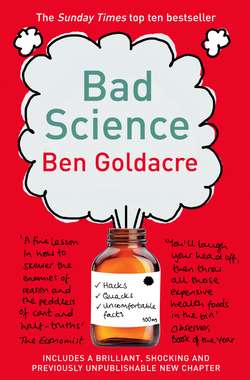Читать книгу Bad Science - Ben Goldacre - Страница 25
What the doctor says
ОглавлениеIf you can believe fervently in your treatment, even though controlled tests show that it is quite useless, then your results are much better, your patients are much better, and your income is much better too. I believe this accounts for the remarkable success of some of the less gifted, but more credulous members of our profession, and also for the violent dislike of statistics and controlled tests which fashionable and successful doctors are accustomed to display.
Richard Asher, Talking Sense, Pitman Medical, London, 1972
As you will now be realising, in the study of expectation and belief, we can move away from pills and devices entirely. It turns out, for example, that what the doctor says, and what the doctor believes, both have an effect on healing. If that sounds obvious, I should say they have an effect which has been measured, elegantly, in carefully designed trials.
Gryll and Katahn [1978] gave patients a sugar pill before a dental injection, but the doctors who were handing out the pill gave it in one of two different ways: either with an outrageous oversell (‘This is a recently developed pill that’s been shown to be very effective … effective almost immediately…’); or downplayed, with an undersell (‘This is a recently developed pill … personally I’ve not found it to be very effective…’). The pills which were handed out with the positive message were associated with less fear, less anxiety and less pain.
Even if he says nothing, what the doctor knows can affect treatment outcomes: the information leaks out, in mannerisms, affect, eyebrows and nervous smiles, as Gracely [1985] demonstrated with a truly ingenious experiment, although understanding it requires a tiny bit of concentration.
He took patients having their wisdom teeth removed, and split them randomly into three treatment groups: they would have either salt water (a placebo that does ‘nothing’, at least not physiologically), or fentanyl (an excellent opiate painkiller, with a black-market retail value to prove it), or naloxone (an opiate receptor blocker that would actually increase the pain).
In all cases the doctors were blinded to which of the three treatments they were giving to each patient: but Gracely was really studying the effect of his doctors’ beliefs, so the groups were further divided in half again. In the first group, the doctors giving the treatment were told, truthfully, that they could be administering either placebo, or naloxone, or the pain-relieving fentanyl: this group of doctors knew there was a chance that they were giving something that would reduce pain.
In the second group, the doctors were lied to: they were told they were giving either placebo or naloxone, two things that could only do nothing, or actively make the pain worse. But in fact, without the doctors’ knowledge, some of their patients were actually getting the pain-relieving fentanyl. As you would expect by now, just through manipulating what the doctors believed about the injection they were giving, even though they were forbidden from vocalising their beliefs to the patients, there was a difference in outcome between the two groups: the first group experienced significantly less pain. This difference had nothing to do with what actual medicine was being given, or even with what information the patients knew: it was entirely down to what the doctors knew. Perhaps they winced when they gave the injection. I think you might have.
